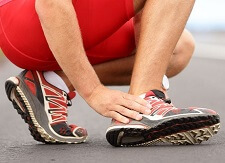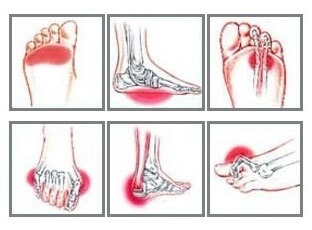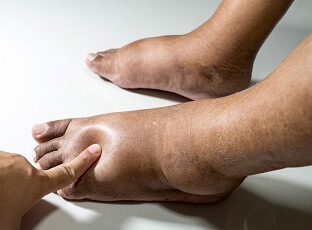- Home
- Common Foot Problems
- Gout Foot
Foot Gout
Written By: Chloe Wilson BSc(Hons) Physiotherapy
Reviewed By: FPE Medical Review Board
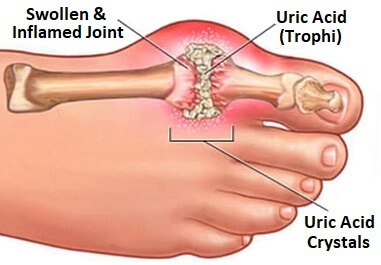
Foot gout is a common problem and is characterised by sudden intense pain, often starting at night with no warning.
Classic foot gout symptoms are localised pain, swelling, redness, heat and tenderness.
Gout in foot most commonly occurs in the big toe but can affect other parts of the foot and ankle.
Here we will look at what is going on during foot gout attacks, common symptoms and diagnosis tools, risk factors and treatment options, and then go on to look at the best gout prevention strategies for avoiding flare-ups.
Common Foot Gout Causes
Foot gout is caused by a build-up of uric acid crystals in a joint. Uric acid is a natural product that is constantly being produced when the body breaks down chemicals known as purines found in foods such as meat and seafood.
Normally, uric acid is filtered and removed through the kidneys and doesn’t cause any problems. However, sometimes the kidneys can’t remove the uric acid quickly enough or the body just produces too much of it.
Over time, this leads to the formation of sodium urate crystals, usually around one of the joints in the body. The tiny crystals are shaped like hard, spiked rods.
Initially, there are no obvious gout symptoms, but as more crystals accumulate (which may take years), they can start to cause problems. If these crystals enter the joint, they irritate the joint lining, triggering an inflammatory reaction, causing intense pain, redness and swelling around the joint.
Gout in foot most commonly occurs at the base of the big toe, known as the metatarsophalangeal joint. Gout affecting the big toe accounts for over 50% of cases of the disease and is also known as Podagra. It is one of the most common causes of toe pain and is the most common type of inflammatory arthritis.
Foot Gout Symptoms
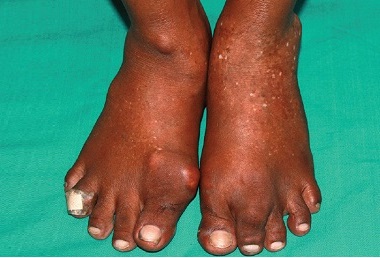
The most common symptoms of foot and ankle gout are:
- Intense pain
- Swelling
- Redness
- Heat
- Tenderness
- Joint stiffness
- Reduced range of motion
In severe cases, foot gout symptoms may also include fatigue and a fever.
Symptoms from gout in foot often start suddenly and progress rapidly over a few hours, particularly at night-time. This is thought to be due to people having a slightly lower body temperature at night.
Gout symptoms usually last between five and ten days but it can take longer for symptoms to subside completely. Gout is a common cause of sudden foot pain without injury.
Gout tends to affect the extremities and Podagra, where it affects the big toe is the most common place to get symptoms of the disease, but people can also suffer from ankle gout or even further up the leg with gout knee.
The upper limbs may also be affected, most commonly the fingers, wrists and elbows. It is thought gouty arthritis most commonly occurs in the extremities as they tend to be the coldest parts of the body, which increases the risk of sodium urate crystal formation.
Phases Of Gout Foot
There are essentially three phases of Gout that sufferers cycle through:
Phase 1: Flare Up
Sudden onset of gout symptoms. Initial flare ups tend to only occur in one joint, but over time, recurrent flare ups often affect more than one joint at a time
Phase 2: Intercritical Gout
This is the period between flare ups when people are symptom free. Some people will only have one episode of gout but over 60% of sufferers will experience a repeat attack within one year. Over time, the frequency of foot gout attacks may increase
Phase 3: Tophaceous Gout
People who suffer from recurrent episodes of gout, or who have high levels of uric acid for a number of years, often acumulate a large number of urate crystals which form lumps or masses known as "Tophi". Tophaceous gout can cause bone damage as the tophi erode bone and cartilage. Whilst tophi tend not to be painful themselves, they can get inflamed and people are often distressed by their appearance.
Gout Risk Factors
Whilst gout foot flare ups often happen for no particular reason, there are a number of factors that have been linked to an increased risk of gout:

- Diet: foods with high purine levels such as seafood, red meat and offal, alcohol (especially beer and spirits) and sugary drinks have been shown to increase the risk of foot gout
- Medical Conditions: such as diabetes, kidney disease, high blood pressure, osteoarthritis and high cholesterol all increase the risk of developing gout foot
- Genetics: In approximately 20% of cases there is thought to be a genetic link with a close family member also suffering from gout
- Obesity: people with a BMI greater than 35 are three times more likely to develop gout
- Medication: some medications increase uric acid levels and therefore the risk of developing foot gout. These include diuretics (water tablets), beta blockers, aspirin (when taken regularly) and niacin (for high cholesterol)
- Gender: Men tend to suffer from foot gout at a younger age than women due to higher levels of uric acid. After the menopause, uric acid level rise in women increasing the risk of the condition and only 15% of female sufferers are pre-menopausal. Over the age of 60, the risk of developing gout foot is equal between the two genders but over the age of 80, it is more prevalent in females.
Gout In Foot Diagnosis
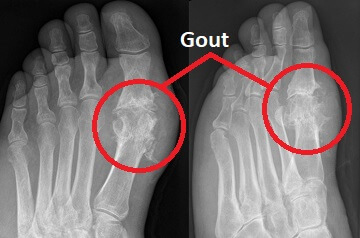
Accurate foot gout diagnosis starts with the doctor asking questions about your symptoms such as when and how they started, previous episodes, diet and any family history of the disease.
Gout may be
suspected from your history but with over two hundred other types of arthritis e.g. hallux rigidus (big toe arthritis),
your doctor may carry out further tests to ensure an accurate gout
diagnosis. This may involve:
- X-rays: Occasionally your doctor may send you for an x-ray but this is usually to either rule out other causes or to look for signs of chronic gout where the bone becomes affected
- Joint Fluid Analysis: Your doctor may take a small sample of fluid from the affected joint using a syringe. This can then be analysed for the presence of uric acid crystals, which gives a definitive foot gout diagnosis
- Blood Tests: These are used to look for high levels of uric acid in the blood, known as hyperuricemia. These blood tests are most reliable 4-6 weeks after the initial gout foot attack. These tests can however be unreliable – 50% of sufferers may never show high uric acid levels whereas people who don’t suffer from the disease sometimes do have high levels
- Ultrasound Scans: These are become more popular as they are a good, non-invasive way of looking for the presence of urate crystals in the joint
How Do You Treat Gout In Feet?
Foot gout treatment aims to reduce the pain associated with the flare up and lower uric acid levels to prevent further attacks by a combination of:
Medication
Foot gout treatment often starts with medications and there are a few different types that can help:
- Anti-Inflammatories: non-steroidal anti-inflammatory medication (NSAIDs) such as ibuprofen and naproxen help to relieve pain and inflammation associated with foot gout
- Colchicine: can help to reduce further attacks, but frequent side effects often limit its use. If tolerated, your doctor may prescribe a small daily dose to try and prevent further gout attacks in the foot such as podagra
- Corticosteroids: If you can’t tolerate NSAIDs or colchicine, your doctor may recommend a short course of oral steroids, or a steroid injection into the affected joint to help relieve pain and inflammation from foot gout. Long term, high dose use is however not recommended due to side effects such as bone thinning and decreased ability to fight infection
Always check with your doctor or pharmacist before taking any new medication
Supplements
Many people find great relief from foot gout by using supplements to reduce uric acid levels. There are a number of different types available that can help to reduce both the frequency and intensity of flare ups. You should always check with your doctor before taking any supplements. Find out more about gout supplements
Applying Ice
Ice therapy can help reduce the pain and inflammation associated with flare ups and often people find it very soothing. But it is really important to use ice correctly otherwise it can make foot gout worse. Visit the Ice Treatment section for advice on how to use ice safely and effectively.
What Else Can Help?
As with most things, prevention is better than cure. There are a number of things you can do to reduce the risk of a gout attack which we look at in detail in the Gout Prevention section. You'll find loads of top tips on things like diet, exercises and life style changes.
Whilst podagra is one of the most common causes of big toe pain, there are a number of other things that it could be - visit the Toe Pain section for help working out what is wrong.
You may also be interested in the following articles:
- Pain On Top Of Foot
- Foot Arch Pain
- Nerve Pain In The Foot
- Foot & Ankle Stretches
- Swollen Feet & Ankles
- Foot Numbness
- Gout Prevention Tips
10 Second Summary
Foot gout is a common type of arthritis caused by high urate levels. Uric acid crystals invade toe joints causing intense toe pain, swelling, redness and heat to develop rapidly, usually at night.
Gout foot treatment and prevention aims to reduce urate levels through a combination of medication, dietary changes, and lifestyle modification.
Related Articles
Page Last Updated: 2nd December, 2025
Next Review Due: 2nd December, 2027
